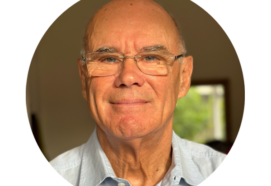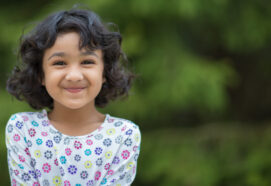In this podcast we talk to Dr. Lynnea Myers about her JCPP Advances paper on Behavioural and Biological Divergence in Monozygotic Twin Pairs Discordant for Autism Phenotypes (https://doi.org/10.1111/jcv2.12017). Dr. Myers is an Associate Professor of Nursing at Gustavus Adolphus College in Minnesota. She has a double PhD in Nursing Science and Developmental Neuroscience.
There is a dearth of studies examining monozygotic ASD discordant twins, and Lynnea explains why this group is so important for inclusion in research to advance the science into non-shared environmental effects, and explains the implications of the findings for professionals working in child and adolescent mental health.
You can listen to this podcast directly on our website or on the following platforms; SoundCloud, Apple Podcasts, Spotify, CastBox, Deezer, Google Podcasts and Radio.com (not available in the EU).

Lynnea Myers graduated with her Bachelor of Arts in Nursing from Gustavus Adolphus College and her Master of Science in Nursing from Duke University. She received a PhD in Nursing Science at Vanderbilt University in Nashville, Tennessee and a PhD in Developmental Neuroscience at the Karolinska Institute in Stockholm, Sweden. She is a licensed registered nurse and holds certification as a public health nurse. Lynnea is a past president of the Minnesota Chapter of the National Association of Pediatric Nurse Practitioners. Bio and image via Gustavus website.
Transcript
Interviewer: Hello and welcome to the In Conversation podcast series for the Association for Child and Adolescent to Mental Health, ACAMH, where we will look at the paper ‘Behavioral and biological divergence in monozygotic twin pairs discordant for autism phenotypes: A systematic review’ recently published in JCPP Advances. I’m Jo Carlowe, a freelance journalist with a specialism in psychology, and I have Dr. Lynnea Myers with me. Lynnea is an Associate Professor of Nursing at Gustavus Adolphus College in Minnesota. She has a double PhD in Nursing Science and Developmental Neuroscience. Lynnea is the first author of the paper we are discussing in today’s podcast.
If you’re a fan of our In Conversation series, please subscribe on iTunes or your preferred streaming platform. Let us know how we did with a rating or review and do share with friends and colleagues. Hi Lynnea, thanks so much for joining me. Can you briefly introduce yourself?
Dr. Lynnea Myers: Yes. Well, thank you for having me today. As you mentioned, I teach at Gustavus Adolphus College and there my areas of specialty are paediatrics as well as public health, and I have a special focus on child development. And it was really that interest that led me to pursue the PhDs that I have, and both of them focused on early identification of children with autism as well as ways we communicate with parents and caregivers about their child’s diagnosis. I currently live in the US, but I actually will be returning to Sweden in 2022 to begin a postdoc with Karolinska and the Mayo Clinic.
Interviewer: As mentioned in the intro, you have co-authored the paper, ‘Behavioral and biological divergence in monozygotic twin pairs discordant for autism phenotypes: A systematic review’ published in JCPP Advances. Can you start with a summary of the paper and tell us what you looked at?
Dr. Lynnea Myers: Yes. So we published the systematic review using what’s known as the PRISMA guidelines, and so with those guidelines, we decided to look at studies that were published from 1992 when we were working on this article, which was last summer, and we used the databases of Medline, Mbase and Psych Info, and what we were looking for was studies that used the co-twin control design to compare biological and behavioural phenotypes in monozygotic or what are known as one egg twins, who were either concordant, so both had autism spectrum disorder, or discordant, where one twin had it and the other didn’t.
Also, we looked at articles not just the pure diagnosis of autism spectrum disorder, but also if they had autism symptoms or what’s known also as autistic traits. When we were looking at studies. We had quite a few when we initially pulled the articles on this kind of topic, but we determined studies to be eligible if they used this co-twin control design, and that’s where you have a pair of twins participate in a study, and for our review, we were specifically looking at twins that were discordant for autism, clinical symptoms, or traits. And we ended up finding 26 articles. Unfortunately, there were very few that were actually focused solely on this monozygotic discordant twin pairs, so we actually had to include also some articles that looked at dizygotic or the two egg twin pairs who were discordant for autism or also monozygotic twins who were concordant for autism. Within those 26 articles, we were able to group our findings into four main categories. So there were articles that looked at genetics or biochemical features, some that looked at brain structure and function, some that looked at cognitive behavioural phenotypes, and then finally some that looked at more physical features or symptoms.
So some of the main findings, we found some differences in methylation of DNA and gene expression among ASD discordant twins, but in general, some of the genetic findings were pretty inconsistent or not replicated in studies. There were some neurological disorders and early medical events that we found associated with autism and autistic traits, but no differences in things like physical anomalies or head circumference. The research on brain structure and function as well as social and cognitive behavioural functions, the articles in those areas were rather inconclusive. So overall, what we found is that the current state of research on these monozygotic twins who are discordant for autism is fairly limited at this moment in its ability to provide insight into potential biological or behavioural issues that could contribute to autism. But they do provide some guidance in helping us identify some areas that might be worthwhile to explore further, like genetics, brain structure, cognitive behavioural issues or physical issues.
One of our findings, and we can go into this more later, is that obviously we need more studies in this area, more monozygotic discordant twin studies. And then another thing that we found is that there needs to be more consistent design, analysis and reporting that authors use when they’re publishing these studies so that it can allow for more robust reviews in the future to be performed.
Interviewer: You’ve highlighted that there was a dearth in studies examining monozygotic ASD discordant twins. Why is this group so important for inclusion in research to advance the science into non-shared environmental effects?
Dr. Lynnea Myers: I just want to start out defining non-shared environment in that, maybe I can’t really define it because I think there is a little bit of controversy in the research about how it truly is defined, but in our paper we defined it as environmental influences that make children who grow up in the same family different. And that could be due to a variety of things. And we offered some examples like epigenetic processes, de novo mutations, illnesses, things going on both when they’re in utero, these twins, as well as when they are outside in the world, like exposure to illnesses and so forth. But why this type of design is so interesting is that these pairs that are especially discordant for autism and are monozygotic, they’re really rare, but they’re really informative. So using this co-twin design that we focused on in this review is really one of the few ways that we can examine these non-shared factors in more detail. And even though research is showing that the potential causes of autism are looking more genetic in a lot of ways where there’s a high liability for genetics, this non-shared environment still seems to be important in an area that we need to explore further.
Interviewer: Can you explain the implications of your findings for professionals working in child and adolescent mental health?
Dr. Lynnea Myers: Unfortunately, probably our findings are still mostly of pre-clinical significance and probably most informative for individuals doing research on twins. So we don’t really have findings that are robust enough yet to communicate to clinicians or even families for that matter, at this point, other than providing some awareness into potential non shared environmental factors that are important in the biology of autism, so things like brain structure and function or the genetics or the physical features. So giving again some clues or some insight into potential causes for autism, but nothing definitive can come out just yet from our review.
Interviewer: Sure. How should researchers then use your findings?
Dr. Lynnea Myers: Yes, I think it really highlights some areas that could be explored further, and I think it highlights the need, as I mentioned a little bit earlier, for more studies using these monozygotic, discordant pairs for autism. But as I mentioned, they’re rare and hard to find. We at Karolinska and specifically at the Centre of Neurodevelopmental Disorders decided to pursue the systematic review because currently we’re doing a study with the RATSS cohort. That stands for the Roots of Autism and ADHD Twin Study in Sweden, and it’s one of the largest studies in the world with a specific purpose of trying to recruit pairs who are discordant for autism and monozygotic. Currently, we have one of the largest samples of pairs that fit that niche, and so that was a little bit of the motivation behind the scenes for doing this review.
Interviewer: Any idea of this type of research being replicated elsewhere in the world?
Dr. Lynnea Myers: There are some other centres that are doing twin research, so I’m aware of some in Australia; there’s a cohort, or there’s a study happening in California, that are specifically, I should clarify, that are focusing more on autism and ADHD. There are twin studies throughout the world that are focusing on other disorders and diseases, but those are some of the ones that we’ve collaborated with or look to or cite in a lot of our papers when we’re doing research. There’s also been some in the UK in the past, and I’m probably forgetting others that are out there, but those are some of the ones that at least when I was doing my PhD at Karolinska were the places that I was aware of.
Interviewer: Lynnea, what other aspects of the systematic review would you like to highlight for our listeners?
Dr. Lynnea Myers: There’s a couple of pieces. I think one of the benefits of our review in the end, we actually wrote in the conclusion section some standards for how to publish articles around monozygotic discordant twins. And that’s something that there was commentary written on our paper that’s I think going to be published in JCPP Advances soon. That also highlighted value of these kind of recommendations we had for future studies using monozygotic discordant twins. I can give you a highlight of some of the kind of recommendations we made. I won’t go through all of them.
But we grouped them into three categories, so there was recommendations under design of studies, analysis and reporting. So, for example, in design, we made a recommendation, and this is very common in autism research, that samples should be more balanced in terms of gender. We did see some samples that were more heavily waived towards males versus females, so we made some recommendations for that. One of the issues that we noticed when we were doing the review is people didn’t have a great definition of discordance, so they didn’t always define what made the pair if they were discordant, so one had ASD and one didn’t. They didn’t always clearly define what was the criteria that was used or cut offs, if there was measures that were used to diagnose ASD, and so that’s something that we really hope future studies will include is that concrete definition of discordance.
When it comes to analysis, one thing, we saw this happening more in the more recent studies, is that when people are doing statistical procedures that they’re accounting for the fact that the twins, their genetics are shared and so that you have to count for statistically the fact that your sample is more similar than other samples that won’t include twins. So just wanting to make sure that researchers did that in future publications. And then in terms of reporting, a couple issues we saw is some studies, especially some of the older ones, weren’t as clear on how zygosity was determined. So this is telling us whether or not a pair is monozygotic or dizygotic. They didn’t tell us if they were using validated methods, if it was just parent report or the twin reports. So that would be something that’s really valuable just to ensure that we’re using the best method to determine zygosity because if we’re not using standard methods then it could influence our results if we don’t actually have a pair who’s truly monozygotic or dizygotic.
Interviewer: I just want to return when you mentioned this under design, where you talked about a good definition of discordance, is there a good definition that you could give us?
Dr. Lynnea Myers: You know that’s something, not to toot our own horn in the RATSS study, but that is something that when this study, the RATSS study was designed in Sweden, they really spent a lot of time trying to characterise the twins really fully, so that we could provide, at least in the publications that came out of the RATSS project, a more clear definition of how we determined discordance. So, in the RATSS study the participants come in for a three day visit and they receive a whole battery of psychological testing. They have physical samples taken and physical measurements performed. But for those psychological tests that are done, there’s actually a group of clinicians then that meets afterwards who perform those tests, and they look at the instruments and they make categorical diagnosis of whether or not a twin has autism or other neurodevelopmental disorders.
But then because we’re using measures that sometimes can give us a numerical value of where a participant is at in terms of things like their autistic traits. So an example is the Social Responsiveness Scale. It’s a measure of autistic traits. We can use that to get what we call a dimensional diagnosis of autism, so we can see on a scale, how many traits does a participant have or where do they rate on that scale for traits compared to their co-twin. It’s still a challenge to find discordance, but what we’re hoping researchers will do moving forward is just include, at least in their method section, a really thorough description of how they define discordance and the tools that they use or the process that they went through. So it allows readers and people performing reviews in the future to really thoroughly critique the research.
Interviewer: It sounds like it will be really important, really helpful. Are you planning some follow up research that you can reveal to us?
Dr. Lynnea Myers: Likely we’ll redo this review in a couple of years, so that’s something further down the pipeline. But as I mentioned in the RATSS project that’s happening currently at Karolinska, they’re doing some analysis at the moment on some hair and teeth samples they’ve taken from the twins, so we use their baby teeth. We don’t make them give us the current teeth. So analysing baby teeth as well as hair samples. And then actually there’s a plan to follow up on pairs that we’ve recruited previously that have been really informative, so a lot of these are the pairs who are monozygotic discordant. So identical twins where one has autism or ADHD or a variety of neurodevelopment disorders, and the other does not. Those end up being fairly interesting pairs to look at because that’s where you can start to explore what is different about those two twins or those two individuals in that twin pair that resulted in one having some type of diagnosis and the other not having it.
Interviewer: Lynnea, what else is in the pipeline that you’d like to mention?
Dr. Lynnea Myers: Yes. So the RATSS project that we’re involved with at Karolinska is part of some bigger projects going on in Europe. So there’s something called the EU-AIMS and AIMS-2 trial, as well as another one called ENIGMA, ASD and ADHD. So we’re a part of those research projects in a research consortia, in part to share the data that we have because we have this rare monozygotic discordant sample that we’ve recruited through RATSS. Also the plans are potentially for the Centre of Neurodevelopmental Disorders at Karolinska to develop a PhD research school on co-twin design, just because it’s an area that they’ve developed some expertise in, and it would be great to train researchers on that type of twin design, and how to do statistical analysis, and how to write reports and publish research on co-twin design.
Interviewer: Finally, what is your takeaway message for those listening to our conversation?
Dr. Lynnea Myers: I think it’s probably a common message that other people have too. More studies are needed, but more studies really are needed using these monozygotic discordant twins for things like autism or other neurodevelopmental disorders, but really with consistent reporting of how the studies performed, so that we can explore this non shared environment a little bit further. I think another thing is if you have an opportunity to participate in research, especially as a twin, your contributions are really valued because there’s a lot that we can learn from this population.
Interviewer: Are there any resources or a website that you can share if somebody was listening and they did want to participate?
Dr. Lynnea Myers: Well, I believe participants in Sweden who are twins and would like to learn more about the research happening at Karolinska, they can actually go to the Karolinska web page and find the Centre of Neurodevelopmental Disorders, but from a worldwide perspective, I’m not entirely sure, but they could obviously look at major research institutions in their area and see if there’s opportunities to be a part of these studies.
Interviewer: Thank you ever so much. For more details on Dr. Lynnea Myers, please visit the ACAMH website, www.acamh.org and twitter at ACAMH. ACAMH is spelled A-C-A-M-H, and don’t forget to follow us on iTunes or your preferred streaming platform. Let us know if you enjoyed the podcast with a rating or review and do share with friends and colleagues.


